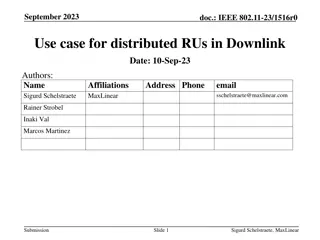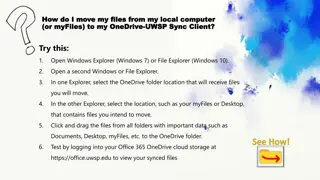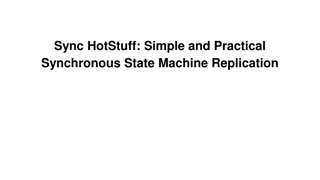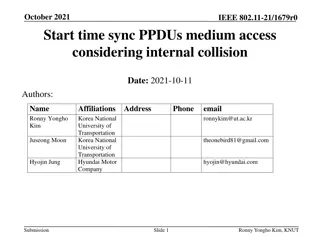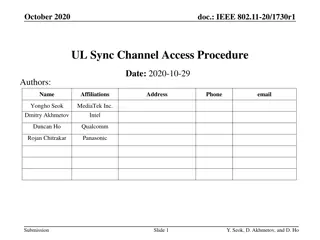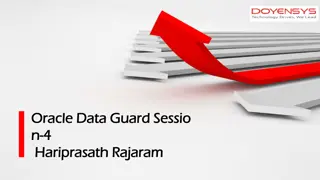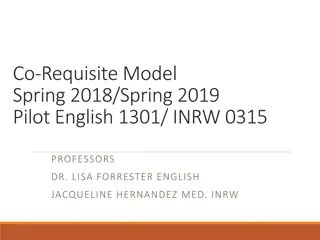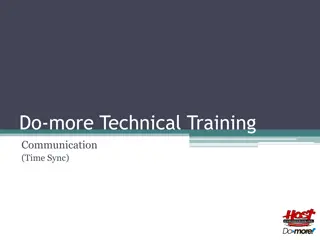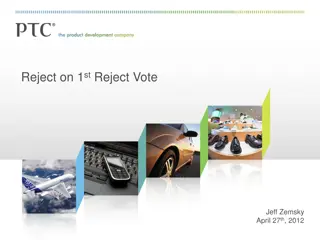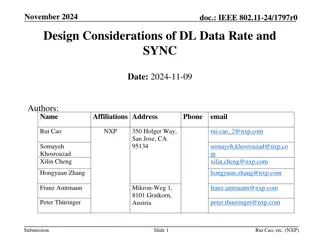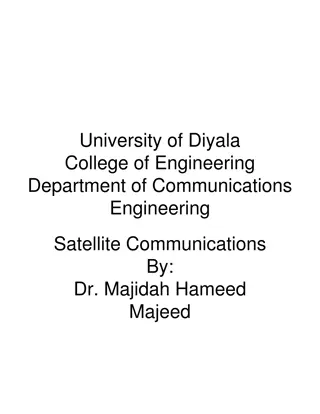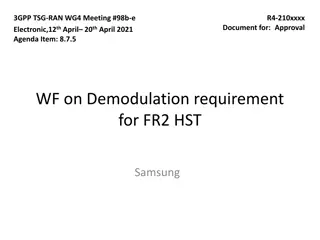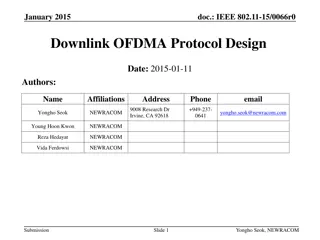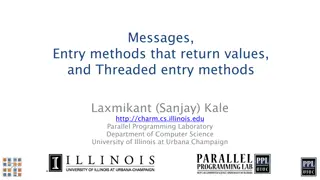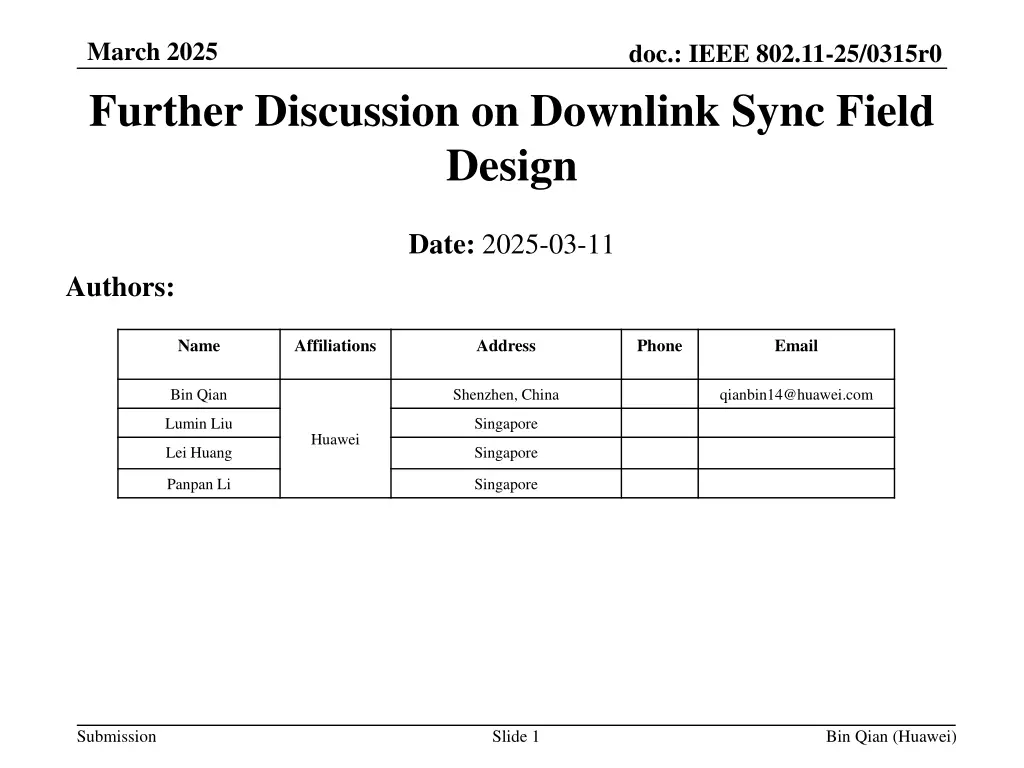
IEEE 802.11-25/0315r0: Further Discussion on Downlink Sync Field Design
Explore the latest discussions on downlink sync field design in IEEE 802.11 communication standards. Topics include AMP-Sync field definitions, criteria for sync sequence design for different communication scenarios, considerations for chip duration uniformity, and more.
Download Presentation

Please find below an Image/Link to download the presentation.
The content on the website is provided AS IS for your information and personal use only. It may not be sold, licensed, or shared on other websites without obtaining consent from the author. If you encounter any issues during the download, it is possible that the publisher has removed the file from their server.
You are allowed to download the files provided on this website for personal or commercial use, subject to the condition that they are used lawfully. All files are the property of their respective owners.
The content on the website is provided AS IS for your information and personal use only. It may not be sold, licensed, or shared on other websites without obtaining consent from the author.
E N D
Presentation Transcript
March 2025 doc.: IEEE 802.11-25/0315r0 Further Discussion on Downlink Sync Field Design Date: 2025-03-11 Authors: Name Affiliations Address Phone Email Bin Qian Shenzhen, China qianbin14@huawei.com Lumin Liu Singapore Huawei Lei Huang Singapore Panpan Li Singapore Submission Slide 1 Bin Qian (Huawei)
March 2025 doc.: IEEE 802.11-25/0315r0 Recap of Current Consensus Motion #18 [1]: The AMP-Sync field in the AMP Downlink PPDU in 2.4 GHz is defined with a chip duration of 2 us for backscattering cases Motion #33 [1]: IEEE 802.11bp defines at least one AMP-Sync in the AMP Downlink PPDU in 2.4 GHz for backscatter communication, and at least one AMP-Sync in the AMP Downlink PPDU in 2.4 GHz for non- backscatter communication. The AMP-Sync is independent of the integrated and non-integrated deployment. This contribution further refines the chip duration and Sync field length parameters Submission Slide 2 Bin Qian (Huawei)
March 2025 doc.: IEEE 802.11-25/0315r0 Sync Sequence Design Criteria: Non- backscatter Communication [2-3] Balanced bit pattern: Equal number of ones and zeros Consecutive symbols limit: Maximum of three consecutive zeros to prevent misinterpretation of an idle channel Auto-correlation property: Must provide reliable detection Cross-correlation: Should minimize interference with the backscatter Sync sequence Preamble padding: The 802.11 preamble field is treated as continuous ON symbols Data rate indication Define a base sequence ? ? (bit-wise complement) indicates 1 Mbps ?,? (repetition) indicates 250 kbps Submission Slide 3 Bin Qian (Huawei)
March 2025 doc.: IEEE 802.11-25/0315r0 Sync Sequence Design Criteria: Backscatter Communication Invalid Manchester pattern inclusion [4] Allow invalid patterns (exactly three consecutive zeros or at least three consecutive ones) as part of the pattern Valid Manchester pattern termination: Must end with a valid Manchester pattern (e.g., 10 or 01) Starting symbol: Begin with 0 to distinguish from the 802.11 preamble or Excitation field Sequence Length: A short sequence (e.g., length 8) is sufficient due to the high SNR at the STA [2, 5] Submission Slide 4 Bin Qian (Huawei)
March 2025 doc.: IEEE 802.11-25/0315r0 Chip Duration Considerations Uniformity Non-backscatter devices should adopt a consistent chip duration, enabling a single correlation process at the STA Data Rate Constraint The chip duration is constrained by the 250 kbps data rate, which demands higher reliability Submission Slide 5 Bin Qian (Huawei)
March 2025 doc.: IEEE 802.11-25/0315r0 Chip Duration Simulation (1/2) Parameters Base sequence ? length DL Sync sequence Local reference sequence Channel model Chip duration Receiver sampling rate at STA Receiver type Values 16 ? ? ? = 2 ? 1 AWGN 2 us, 1 us, 0.5 us 8 MHz ED receiver Submission Slide 6 Bin Qian (Huawei)
March 2025 doc.: IEEE 802.11-25/0315r0 Chip Duration Simulation (2/2) Sync detection performance Data decoding performance At 0.5 us, the Sync detection performance is lower than that of data decoding At 1 us, the Sync detection performance shows an improvement, yet the performance margin remains limited Simulation results indicate that a chip duration of 2 us delivers robust Sync detection performance Submission Slide 7 Bin Qian (Huawei)
March 2025 doc.: IEEE 802.11-25/0315r0 Sequence Length Considerations (1/2) Reliability requirement: The Sync field must be more reliable than the data field for stable synchronization Impact of Manchester encoded data: Random Manchester encoded data can degrade auto-correlation performance Normalized correlation peak [6] could be used to evaluate the effect of random Manchester encoded data on Sync field reliability Submission Slide 8 Bin Qian (Huawei)
March 2025 doc.: IEEE 802.11-25/0315r0 Sequence Length Considerations (2/2) A base sequence length of 8 shows high cross-correlation with the data field, risking false detections Submission Slide 9 Bin Qian (Huawei)
March 2025 doc.: IEEE 802.11-25/0315r0 Sequence Length Simulation (1/3) Parameters Base sequence ? length DL Sync sequence Local reference sequence Values 16, 12, 8 ? ? ? = 2 ? 1 Channel model Sync chip duration Data rate Receiver sampling rate at STA AWGN, Channel D 2 us 250 kbps 8 MHz Submission Slide 10 Bin Qian (Huawei)
March 2025 doc.: IEEE 802.11-25/0315r0 Sequence Length Simulation (2/3) Data decoding performance Sync detection performance A base Sync sequence length of 8 shows an evident error floor Submission Slide 11 Bin Qian (Huawei)
March 2025 doc.: IEEE 802.11-25/0315r0 Sequence Length Simulation (3/3) Data decoding performance Sync detection performance Although base sequence lengths of 12 and 16 meet the 20-byte payload data decoding requirements, a length of 16 provides a better performance margin Based on simulation results, we recommend adopting a base Sync sequence length of 16 Submission Slide 12 Bin Qian (Huawei)
March 2025 doc.: IEEE 802.11-25/0315r0 Summary AMP-Sync field design criteria overview Cross-correlation between non-backscatter and backscatter Sync fields must be minimized to reduce false alarms Chip duration A uniform 2 us chip duration is suggested to simplify receiver design and meet the 250 kbps reliability requirement Sync sequence length Non-backscatter: Length-16 for 1 Mbps and Length-32 for 250 kbps Backscatter: Length-8 is sufficient Submission Slide 13 Bin Qian (Huawei)
March 2025 doc.: IEEE 802.11-25/0315r0 References [1] 11-24-1322-06-00bp-tgbp-motion-dock [2] 11-25-0047-00-00bp-follow-up-on-downlink-sync-field-design [3] 11-25-0034-00-00bp-sync-field-for-amp-ppdu [4] 11-24-1797-00-00bp-design-considerations-of-dl-data-rate-and-sync [5] 11-25-0075-02-00bp-further-thoughts-on-amp-dl-ppdu-for-mono-static- backscattering [6] 11-18-1201-00-00ba-concerns-about-sync-detector-false-alarms Submission Slide 14 Bin Qian (Huawei)
March 2025 doc.: IEEE 802.11-25/0315r0 Straw Poll #1 Do you agree to add following content to TGbp SFD: The AMP-Sync field in AMP Downlink PPDU in 2.4 GHz is defined with chip duration of 2us for non-backscattering communication Submission Slide 15 Bin Qian (Huawei)
March 2025 doc.: IEEE 802.11-25/0315r0 Straw Poll #2 Do you agree to add following content to TGbp SFD: For Active Tx non-AP AMP STA and AMP Enabled non-AP STA, the AMP-Sync field structure in the AMP Downlink PPDU in 2.4 GHz depends on the data rate of the AMP-Data field. When the AMP-Data field data rate is 1 Mbps, the structure of the AMP-Sync field is ?, where ? is a sequence of 16 bits, and ? is the bit-wise complementary sequence of ?. When the AMP-Data field data rate is 250 kbps, the structure of the AMP-Sync field is ? ? . The specific bit sequence of ? is TBD. Submission Slide 16 Bin Qian (Huawei)
March 2025 doc.: IEEE 802.11-25/0315r0 Appendix Base sequence used Length 16: (1) 1 1 0 0 0 1 1 0 1 0 0 0 1 0 1 1; (2) 0 0 1 1 0 1 0 1 1 0 1 0 0 0 1 1 Length 12: 0 1 0 1 1 0 0 0 1 1 0 1 Length 8: 0 1 0 1 1 0 0 1 Submission Slide 17 Bin Qian (Huawei)


